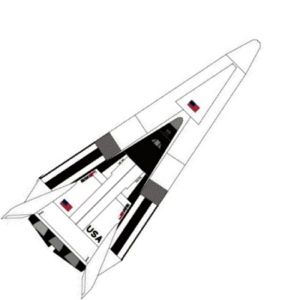
Home - Search - Browse - Alphabetic Index: 0- 1- 2- 3- 4- 5- 6- 7- 8- 9
A- B- C- D- E- F- G- H- I- J- K- L- M- N- O- P- Q- R- S- T- U- V- W- X- Y- Z
Starclipper Light
 Starclipper Credit: © Thomas Kladiva - Thomas Kladiva |
AKA: Starlifter. Status: Study 1968. Payload: 11,340 kg (25,000 lb). Thrust: 4,070.50 kN (915,085 lbf). Gross mass: 300,408 kg (662,286 lb). Height: 38.20 m (125.30 ft). Diameter: 8.00 m (26.20 ft). Apogee: 555 km (344 mi).
A downsized version of Lockheed's 'Starclipper' concept gained international prominence when George Mueller, NASA's Associate Administrator for Manned Space Flight, presented a downsized version of the design at a British Interplanetary Society meeting in August 1968. Mueller described the vehicle as a "space shuttle" primarily intended for space station crew transfer and resupply missions. Mueller and Hunter both stressed the importance of airplane-like low-cost operations and manufacturing techniques. Thus, the Starclipper was designed to take-off and land from air bases or major airports, although it did require a custom-built launch pad as well as clear areas downrange since the spent propellant tanks would be hazardous to people and property.
A combination of standardized refurbishment processes and ground support equipment, and self-contained on-board checkout systems would have purportedly have reduced the cost of launching payloads to as little as $15.00 per kilogram with turnaround times between flights of only 24 hours. The smaller version of Starclipper was sized for modular 11,300-kilogram space station payloads. Mueller described it as being ideal for satellite retrieval, repair and inspection of satellites as well. Apart from the computerized onboard checkout system, the biggest technical challenges appeared to be the main engines and thermal protection system. The alternate high-pressure engines accounted for 25% of the Starclipper's landing weight and featured two-position nozzles for added efficiency.
The Starclipper's passively cooled re-radiative-insulative structure was designed for 10-100 reuses and easy maintenance and replacement.
LEO Payload: 11,340 kg (25,000 lb) to a 555 km orbit at 55.00 degrees. Flyaway Unit Cost 1985$: 28.000 million.
Family: orbital launch vehicle, Winged. Country: USA. Agency: Lockheed. Bibliography: 36, 512, 513.
Back to top of page
Home - Search - Browse - Alphabetic Index: 0- 1- 2- 3- 4- 5- 6- 7- 8- 9
A- B- C- D- E- F- G- H- I- J- K- L- M- N- O- P- Q- R- S- T- U- V- W- X- Y- Z
© 1997-2019 Mark Wade - Contact
© / Conditions for Use